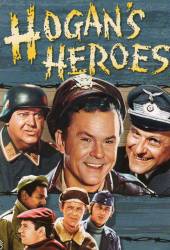Continuity mistake: When Klink is talking to Schultz, his monocle is in before he bends down, missing when he's looking at Schultz, and back when he straightens up.
Continuity mistake: As Schultz is going to get checked out, Hogan and the boys stop him, and Hogan feels Schultz's neck. Schultz's arms are by his sides, then after the angle change, they're by his hips. Also, there's two men walking behind the group that weren't there a second before.
Continuity mistake: When Klink is talking with the doctor, he sits while reading the report. One moment, he's holding the folder, the next, his hands are folded without having dropped the folder.
Continuity mistake: As Schultz comes in, Klink has his left hand on his forehead. As Schultz is talking, Klink starts to raise his head, his hand very close to his forehead. When the camera cuts to a close up, his hand is below chin level.






Answer: It's a solitary cell. Steve McQueen, star of 'The Great Escape' is known as the 'Cooler King'.